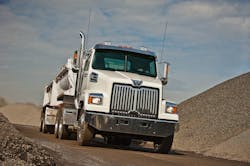Reliability, performance, efficiency and low cost of ownership are all important factors to consider when spec’ing a new truck. Driven by a need for improved fuel efficiency and greater payloads, the trucking industry has turned toward lightweight designs and engine downspeeding in recent years to achieve impressive fuel savings. However, lightweight components still have to supply exceptional durability.
“At Dana, we understand that one of the most significant concerns of fleet maintenance managers tends to be uptime,” says Steve Slesinski, director, product planning, commercial vehicle market, Dana Incorporated. “If a breakdown occurs, it can lead to unexpected downtime, expensive repairs, late deliveries and other problems.”
Dana (www.dana.com) is a world leader in highly engineered solutions for improving the efficiency, performance and sustainability of powered vehicles and machinery. The company supports the passenger vehicle, commercial truck and off-highway markets, as well as industrial and stationary equipment.
“As you consider all powertrain components on a new truck, our best advice is to spec for uptime,” he says. “Select components that have been carefully engineered, thoroughly tested and proven to deliver the performance and durability required for your unique situation.”
Component Failures
“Axle, driveshaft and transmission failures are often caused by improper selection of components for the desired application and duty cycle,” Dana’s Slesinski points out. “Improper spec’ing can also lead to premature and extended maintenance needs.
“Many factors should be taken into consideration, including engine capability, transmission speed and desired cruise speed, as well as torque and horsepower requirements.”
Duty cycle is also important, he adds, and that includes anticipating the grades and speeds at which the truck will operate and the weight it will transport.
Gross vehicle weight rating (GVWR) and gross combination weight rating (GCWR) should be factored in, Slesinski says.
“Keep in mind that weight limits vary across states and provinces in North America,” he says. “Don’t limit yourself to an 80,000-lb GVWR when some regions allow trucks to pull up to 110,000 lbs.”
Dana offers tandem axles and driveshaft systems designed for linehaul applications to support GVWRs up to 110,000 lbs.
Drivelines Optimized for Engine Downspeeding
Axle ratio is impacted by whether an overdrive or direct drive transmission is chosen, and there are additional considerations if a system designed for engine downspeeding is being spec’d, Slesinski of Dana says.
“An engine running at lower rpm requires faster axle ratios to maintain the same vehicle speed and performance at highway cruise speed, and it requires significantly higher torque stresses in the driveline system,” he says.
By way of example, he says the Dana system optimized for engine downspeeding includes the Spicer AdvanTEK 40 tandem axle, “which offers the industry's narrowest ratio steps from 2.26:1 to 2.93:1. This range allows truck buyers to fine-tune driveline specifications for an optimized balance of productivity and fuel efficiency.
“Recently introduced, a new 2.47:1 ratio is ideally suited to support high efficiency and performance in direct-drive transmission configurations.”
“[The Spicer AdvanTEK 40 tandem axle offers] a powerful combination of technologies that can enable an engine at highway cruise speed to run up to 200 rpm lower than alternative powertrain systems, while still reducing weight, increasing axle efficiency and maintaining performance,” Slesinski says. “Together with the SPL 350 driveshaft and SPL 250 inter-axle shaft, this complete driveline system has been designed to handle higher input torque from downsped engines, compared with competitive powertrains, providing further weight and cost savings in select applications.”
6x2 Axle Configurations
“Another proven method in the quest for fuel efficiency is the 6x2 axle,” notes Dana’s Slesinski. “Featuring a single rear drive axle and a second rear tag – also known as a pusher axle or dead axle, this configuration eliminates the driveshaft, inter-axle shaft and other components that would connect the rear axles in a 6x4 configuration.”
In a 6x2 configuration, only one of the two rear axles receives power. In a 6x4, both of the tractor’s rear axles are drive axles.
“The 6x2 axle offers low cost of ownership and weight savings to over-the-road drivers operating on flat, smooth pavement in primarily dry-weather conditions when torque on all four wheel ends is not critical,” he says.
Dana’s Spicer EconoTrek tandem axle for 6x2 configurations weighs up to 400 lbs less than a traditional 40,000-lb 6x4 tandem axle system arrangement. Available in 21 different ratios for vehicles with a GCWR up to 125,000 pounds, the axle offers innovations for reducing maintenance and increases the fuel economy of heavy duty linehaul tractors by to 3 percent, Slesinski says.
Heavy Duty Hauling
Dana’s Slesinski notes that for fleets hauling extremely heavy cargo, performance capability often trumps fuel-saving technologies.
“Optimal operation and durability are critical in heavy and severe duty applications, such as construction, mining and logging,” he says.
He recommends a single reduction heavy duty tandem axle that supports a wide range of axle ratios, such as the Spicer D46-170. It has ratio coverage from 3.07 through 7.17:1, “allowing maximum performance across a variety of vocations.”
This axle features a high-capacity gearing and bearing system to handle higher horsepower and torque, and a driver-controlled wheel differential lock for maximum traction. Extra wide, face-width gearing provides greater strength for increased durability at higher loads.
With so many possibilities, Slesinski advises working with axle and driveline suppliers to find the best solution for any scenario required by a fleet.
About the Author

